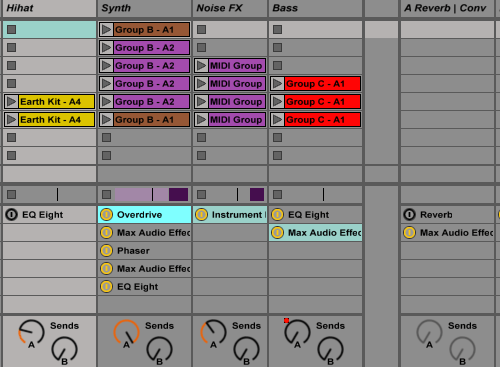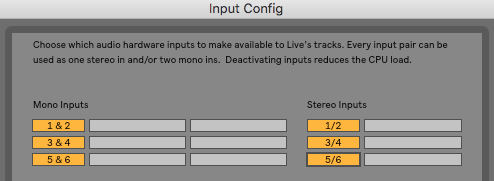More on Ableton.com:
May 08, 2018 How to reset Ableton Live to default settings To troubleshoot issues with Live, you can reset to default settings in case the problem has been caused by corrupted setting files. Resetting Live won’t delete any important files, such as project files and presets. Oct 03, 2017 Here is how to analyze and figure out why Ableton is crashing! Works on MAC too! Get Visual Studio (Express Edition): https://www.visualstudio.com/vs/visual.
More from Ableton:
Get all the features of Live 10 Suite free for 90 days.
On a mobile device? Live is fast, flexible music software for Mac and Windows.
Your data could not be submitted. Please try again.
Thanks. You will receive the download links shortly.
Thanks. You will receive the download links shortly. We’ve also sent you a separate email confirming your newsletter subscription.

System Requirements
End User License Agreement
What is Ableton Live?
Ableton Live lets you easily create, produce and perform music within one intuitive interface. Live keeps everything in sync and works in real-time, so you can play and modify your musical ideas without interrupting the creative flow.
Live comes with a versatile collection of instruments, sounds, kits and loops for creating any kind of music and provides a full complement of effects to tweak and process your sound.

Ableton Live 10 Suite includes:
- Ableton Live
- 13 Instruments to try (including Wavetable, Operator, Sampler, Analog and more)
- 56 Effects for processing audio and MIDI (including Echo, Pedal, Beat Repeat, Amp, Vocoder, Glue and lots more)
- Instant mappings so you can use Live with your keyboards or controller.
- Max for Live so you have access to a range of instruments, effects and customizations created by the Live community.
Installation on a Mac
Open the DMG and drag Live to your applications folder. Then open Live and follow the instructions there. If you want to uninstall the trial at any point, you can find help here.
Using Live 9?
You can install the trial next to Live 9. Your library will not be overwritten or altered.
Ableton Live Preferences.cfg Mac Download
System Requirements
Ableton Live Preferences.cfg Mac Pro
PC
- Windows 7 (SP1), Windows 8 or Windows 10 (64-bit)
- 64-bit Intel® Core™ or AMD multi-core processor (Intel® Core™ processor or faster recommended)
- 4 GB RAM (8 GB or more recommended)
- 1366x768 display resolution
- ASIO compatible audio hardware for Link support (also recommended for optimal audio performance)
- Access to an internet connection for authorizing Live (for downloading additional content and updating Live, a fast internet connection is recommended)
- Approximately 3 GB disk space on the system drive for the basic installation (8 GB free disk space recommended)
- Up to 76 GB disk space for additionally available sound content
Mac
- OS X 10.11.6 or later
- Intel® Core™2 Duo Processor (Intel® Core™ i5 processor or faster recommended)
- 4 GB RAM (8 GB or more recommended)
- 1280x800 display resolution
- Core Audio compliant audio interface recommended
- Access to an internet connection for authorizing Live (for downloading additional content and updating Live, a fast internet connection is recommended)
- Approximately 3 GB disk space on the system drive for the basic installation (8 GB free disk space recommended)
- Up to 76 GB disk space for additionally available sound content
In this Ableton Live tutorial, Dubspot’s Rory PQ shares five workflow tips to improve productivity and streamline your approach to music creation. Check out our DJ/Producer Master Program, classes start soon.Enroll Today!
MIDI Editing with Ghost Notes

Ableton Live Preferences.cfg Mac Version
Have you ever been working on a tune and thought something was off like some notes are clashing, or the rhythm isn’t right? A great workflow tip to help align your grooves is to create ghost notes so you can visually see MIDI note patterns for multiple tracks in one place. Creating ghost notes is a fast and easy way to reference multiple MIDI notes patterns from different tracks so you can quickly fine-tune your note placements and get everything playing nicely together. For example, if your lead melody is not playing smoothly with your bass melody, you could copy/paste the lead MIDI notes into the bass MIDI clip, deactivate them and visually correct any clashing notes.
There’s nothing scary about ghost notes. The setup is a breeze.
- Copy MIDI note patterns from one or more tracks
- Paste the copied MIDI note patterns into the MIDI clip you wish to edit
- Shift the copied notes up or down an octave to avoid overlapping notes
- Select all the notes you just copied and click “0” to deactivate them all
- Click the Fold button to hide all the rows that do not contain MIDI notes
Road Map to Arrangement
Song structure is a crucial ingredient in the development of a tune and is often the most troublesome process. Arranging the structure of a song can sometimes be a headache. This next workflow tip will help you speed up the process and allow you to arrange your tune quickly. When its time to start laying out the different elements try referencing the arrangement from another tune and use Live’s Locators to map out a visual guide to structuring your tune. Locators are play markers that provide a visual representation where changes in the tune occur. Using reference tracks is a tried and tested method for arrangement and mixing.
Creating a visual guide for arrangement is quick and easy.
- Drag in a full-length tune with a song structure you like
- Warp the tune if you plan on working in a different BPM
- Deactivate the track so it is not audible
- Looking at the tunes waveform, move along the timeline and locate different sections of the tune such a Verse, Chorus, Breakdown, Bridge, etc. Split the track at each section by clicking CMD [MAC] / CTRL [PC] + E
- Rename each clip appropriately and color-code them to quickly identify the different sections.
- Follow the same song structure to arrange your tune
Hidden Feature: Show/Hide Devices on Tracks
Wouldn’t be great if we could see all the loaded devices on each track without having to click on each track and scroll along the device chain? Well, you can but for some odd reason Live left this feature out for us to set up manually. The Show/Hide Devices feature works great for referencing loaded devices, as well as allow us to enable/disable devices with ease to AB the effect.
Simply follow the steps below to enable this feature:
- Create a plain text file and rename it Options.txt
- Open the file and type ‘-ShowDeviceSlots’ (without apostrophes)
- Copy the file to Live’s installation folder. Same folder as Live’s Preferences.cfg file
Nice work! Fire up Live and in the lower right side of the screen you will see a new button that looks like a plug. Enabling /disabling this button will show/hide device slots in Session View.
Extracting Chains from Drum Rack
One of the quickest ways to jump-start a tune is to load a Drum Rack and start banging in some beats. This approach is fast, and it allows you to see each drum element visually in one place for easy editing. However, in the long run, it is restrictive and doesn’t allow as much control as it does when each element is on individual tracks.
Luckily, Live’s Extract Chains feature lets us enjoy the best of both worlds. Extracting chains from Drum Rack is a great way to move each drum element to a dedicated track with ease. Giving you more control over each sound. For example, you could load up a Drum Rack, quickly record in a beat on a single track, edit notes as needed, and then extract the chains to individual tracks for more control. To extract a chain, simply right-click the chain you wish to extract and choose Extract Chains from the context menu. Live will create a new track with a new set of MIDI clips containing only the notes from that chain.
Hidden Feature: Copy Parameter Values to Siblings
This final workflow tip involves some initial setup, but it is a huge time saver when you want to copy the same parameter settings to multiple instances of the same device in Drum Rack. The Copy Values to Siblings feature works great when you want to apply the changes to the same device located on each pad in one click of a button. For example, say you just used Live’s Convert Audio to MIDI feature to chop an audio loop into a Drum Rack. Now you want to set the same amount of Decay to each sample across Drum Rack’s pads. Well, without the Copy Values to Siblings feature you would have to click on each pad and manually adjust the Decay control of each Simpler device. The Copy Values to Siblings feature saves the day by allowing you to send the same value to each device at once by simply right-clicking any parameter and choosing Copy Value to Siblings from the context menu.
Simply follow the steps below to enable this feature:
- Create a plain text file and rename it Options.txt
- Open the file and type ‘-EnableMapToSiblings=1’ (without apostrophes)
- Copy the file to Live’s installation folder. Same folder as Live’s Preferences.cfg file
Ableton Live Producer Certificate Program
The flagship of our music training, with every Ableton Live course offered at the school. After completing this program, you will leave with a portfolio of original tracks, a remix entered in an active contest, a scored commercial to widen your scope, and the Dubspot Producer’s Certificate in Ableton Live.
What’s Included:
- Ableton Live Level 1: Beats, Sketches, and Ideas
- Ableton Live Level 2: Analyze, Deconstruct, Recompose, and Assemble
- Ableton Live Level 3: Synthesis and Original Sound Creation
- Ableton Live Level 4: Advanced Sound Creation
- Ableton Live Level 5: Advanced Effect Processing
- Ableton Live Level 6: Going Global with your Music
This program is about learning Ableton Live by going through the entire process of being an artist, by developing your own sound through a series of sketches and experimentation. You will also learn the ins and outs of this powerful software through a series of exercises designed to help you master the steps involved in producing your own music. After a level of getting familiar with the tools that Ableton has to offer, you will then develop your sonic ideas into full-length tracks. You will be exposed to a variety of approaches to arrangement and composition, storytelling techniques, ways of creating tension and drama in your music. At the end of the day, it is the sum total of your choices as an artist that define your sound, and levels 2 – 6 will give you the experience of actually completing tracks to add to your portfolio.
If you have questions, please call 877.DUBSPOT or send us a message.